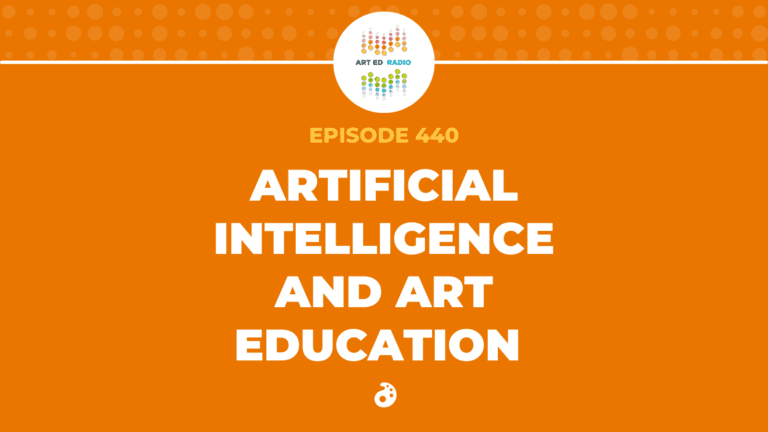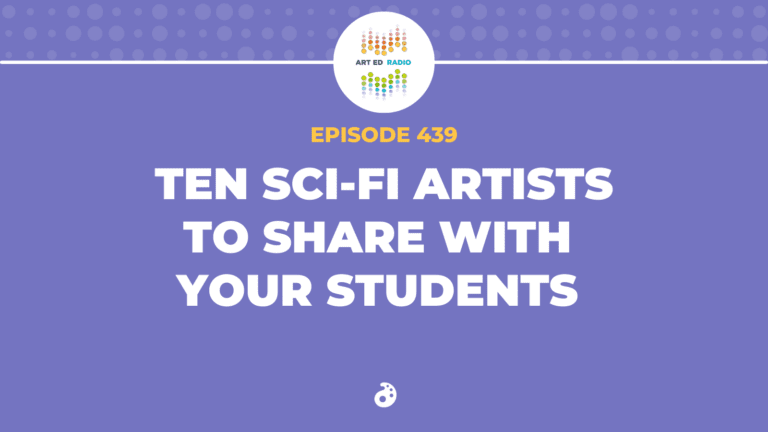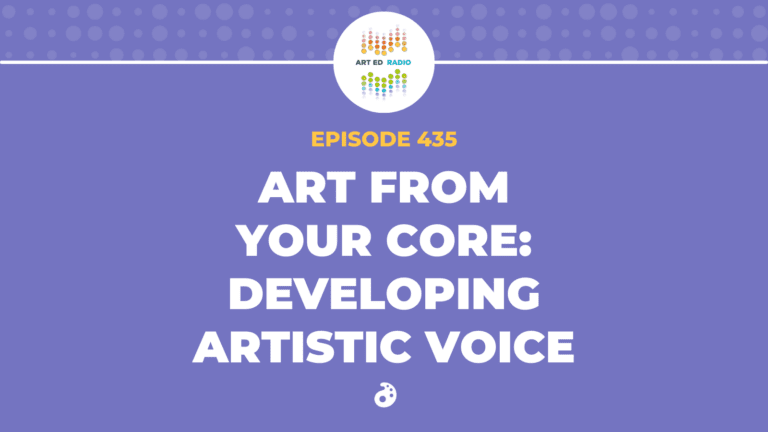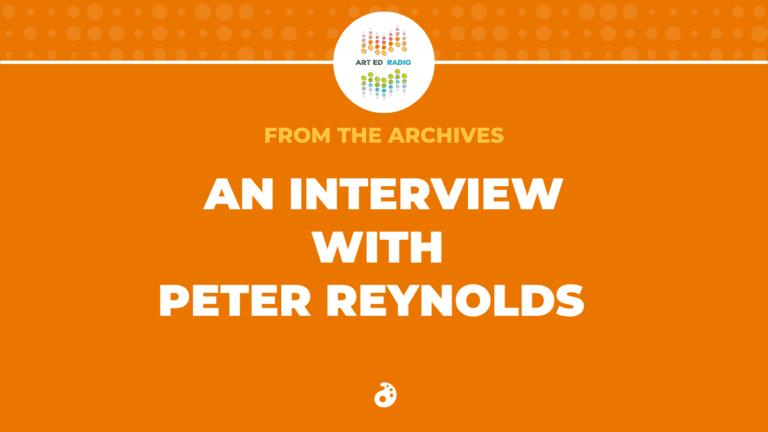We hear all the time about how our students should be working together and how we need to give them opportunities to collaborate. But what exactly does that look like in the art room? What could it look like? In today’s episode, Jessica Provow returns to the show to share ideas from a project she has developed for her students. Listen as she and Tim discuss the planning and execution of her collaborative project and what students gain from the experience. Full Episode Transcript Below.
Resources and Links
- Listen to Jessica’s previous podcast appearance
- See the Collaboration in the Art Room PRO Learning Pack
- Finding Success with Collaboration at the Elementary Level
- How Student-Directed Collaboration Can Benefit Your Students
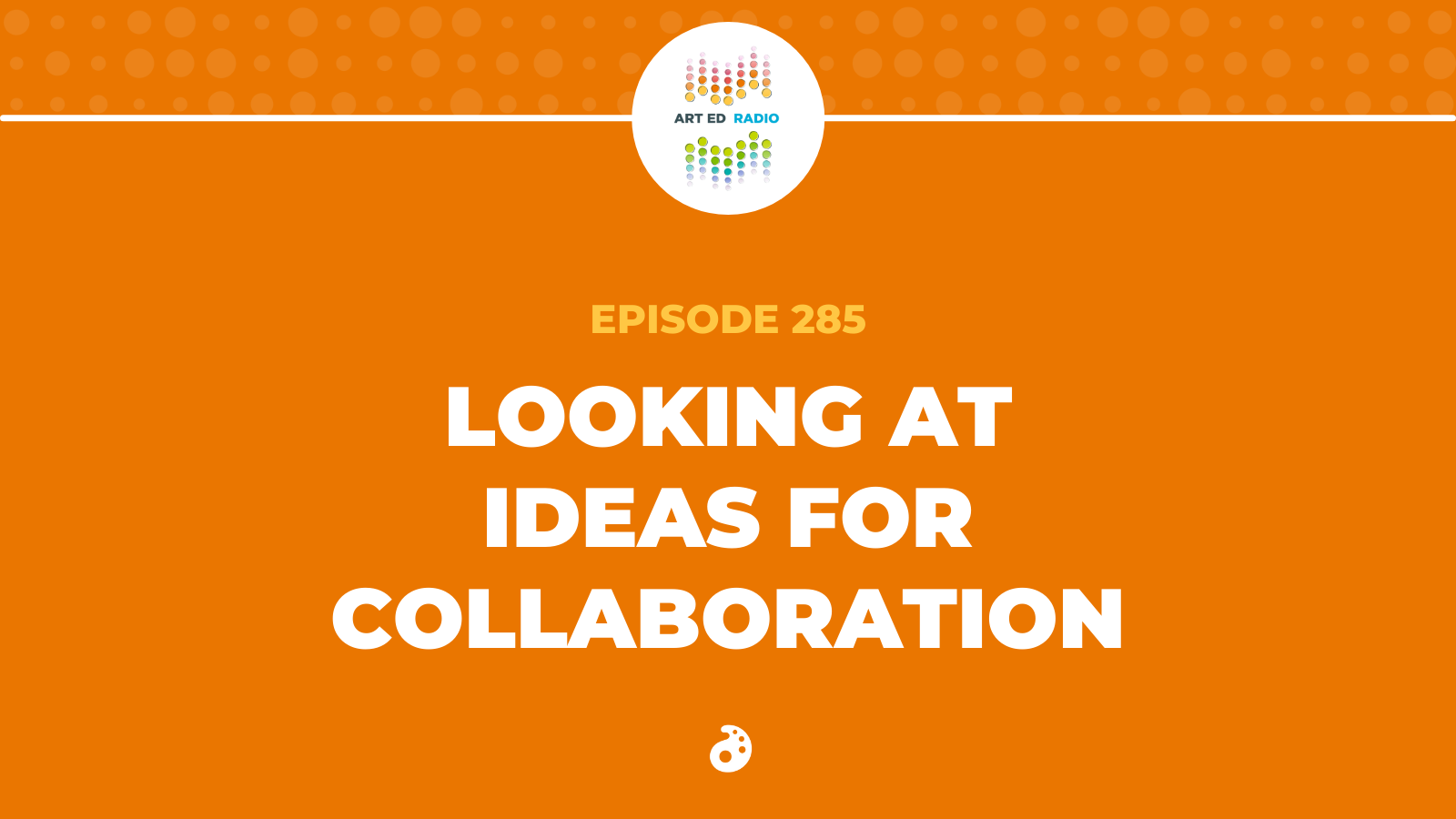
Transcript
Tim: Welcome to Art Ed Radio, the podcast for art teachers. This show is produced by The Art of Education University, and I’m your host, Tim Bogatz.
Now, before we begin today, I wanted to share a story with you just around my house here and all my work stuff in my backpack. Because I’m irresponsible sometimes, it was lying in the middle of the floor and my wife starts yelling at me like I’m a seventh grader. She’s joking, of course, but she teaches seventh grade. She’s got all these questions for me. Why do you have a backpack on the floor? Why didn’t you put it where you’re supposed to? Why are you having so much trouble following directions?
Why can’t you do what you’re supposed to do? And then she actually tells me about a teacher who broke her arm tripping over a kid’s backpack at her school a few years ago, which is scary and I didn’t remember that happening. I felt really bad about that, but it also reminded me of a story about me tripping over a backpack and splitting my pants. I was a young teacher back in the day. I was on a cart. I was teaching elementary art, traveling room to room.
I was teaching a first grade class. It was toward the end of the day, but there’s still like an hour or so left, but they had packed up a little bit early. They’re ready to go. It was a Friday and they had their backpacks lying on the ground. It wasn’t that big of a deal, but I turned away from my kid and I tripped over a backpack and sort of stumbled and caught myself. But in the process of that, I hear just this huge ripping sound, and I had just rip the seam of my pants. It was ridiculous. It was a huge rip.
It was loud enough that a few kids stopped what they are doing and looked over at me. And then I have this little first grader look at me and literally like points and laughs. And he goes, “You have a hole in your butt,” which you know, yeah. But it’s like that… It’s not the best moment of my teaching career. I didn’t know exactly what to do in the moment. I just took the apron that I had on and flipped it around. I was wearing the apron backwards and it covered up my issue there. I had a couple classes left to teach.
I just walked to those teachers to explain what was going on. I was super nervous to talk to them because, A, this was kind of embarrassing. B, I was a first year teacher. Both of those teachers whose classes I was supposed to come into, they just kind of laughed about it. They’re experienced teachers. They thought it was pretty funny, and they’re like, “You know what? It’s fine. You don’t need to come in today. We can teach art ourselves, or we can handle it,” or I don’t remember exactly what it was.
I just remembered I had a giant hole in my pants, and I was ready to get out of there. Anyway, I got to go home about an hour early, but it was not a pleasant experience in any way. Moral of the story I guess is to watch where you’re going or to leave backpacks out of the way in the first place. I don’t know, but hopefully you don’t split your pants and definitely hope that you don’t trip and break your arm. Anyway, be careful with those backpacks. However, you did not come to this podcast today to listen to me and talk about backpacks.
We are going to chat today with Jessica Provow. Jessica is an awesome teacher. She came on earlier this year. We had a really good conversation about her end of year portrait projects. You may remember that one. It was a great episode, and she has a lot to share in there. Really cool process of what she does with that. That’s worth a listen if you did not catch it the first time around. But she’s back today talking about a new project that she has been working on and a presentation coming up that she’s giving to the Virginia Art Education Association.
I think that’s next month, and this project that she’s doing is a collaboration between school and community. There is a surf shop, I believe it is, who donate surfboards to her students, like used surf boards, and they team up to create paintings on top of the boards. And then they take those surf boards, they’re put back on display in like a community art show that are also for sale. It’s a really, really cool fundraiser. It’s a cool idea. And I want to hear about all of that from Jessica, so here she is.
All right, and Jessica Provow is back on the show now. Jessica, how are you?
Jessica: I’m doing good. Thanks for having me.
Tim: Oh, well, thanks for coming back. It’s really good to talk to you again, but can you tell us about just how things are going for you? How the school year has been for you so far?
Jessica: Yeah. Things have been going really great so far. Students are all back in person and I’m loving it.
Tim: Yes.
Jessica: It’s great to finally see kiddos that I haven’t physically seen in person in the past two years. It’s funny, they’re usually either way taller or shorter than I imagined since I’ve only seen them on Zoom through a one-inch box.
Tim: Yeah, that’s got to be a weird situation. How are the kids feeling? Are they excited to be back in person? Are they excited to see each other? What has it been like for them?
Jessica: They are definitely excited to see each other. There is a little sense of quietness because of the mask, but you still see that spark in their eyes when they get into the art room and when they see each other. They know people that they haven’t seen in two years. It’s really great.
Tim: Yeah, that’s a really, really cool thing. That’s good to hear. Now, the reason I wanted to chat with you today though is you have a big project coming up and I guess a class that you’re teaching for the Virginia Art Education Association. Can you tell us just a little bit about what’s happening there, about what you have going on?
Jessica: Yeah. The project is a collaborative community project that our eighth grade artists participate in. I’m actually teaching a lecture style class on it at the VAEA in October. I’ll be explaining the project itself, showing off student examples, and discussing the partnership benefits between the school and the community. Really exploring opportunities for student work to be seen beyond the art room walls. For this project, my students get the opportunity to paint on donated surfboards, which are such a unique surface to explore.
Tim: I’m sure.
Jessica: And when finished, these paintings are put on display in the community for all to see and are also for sale.
Tim: Okay. That sounds really, really cool. I’ve never painted a surfboard before. It sounds fascinating. It sounds like a really cool project. But I guess the question that jumps to the front of my mind, you said you partner with the community for this project. How exactly does one just go about collecting a bunch of surfboards and getting surfboards for students to paint?
Jessica: Oh, it’s so easy. Most businesses are willing and happy to donate to schools and to support the arts. And here in Virginia Beach, we have a big emphasis on community art and we have a growing art hub called the ViBe District, which consists of local artists, businesses, and the Museum of Contemporary Art. Through the ViBe District, businesses are getting revamped with murals and stores are opening their doors and spaces to artists to sell their artworks.
In thinking about this within our community space, I just reached out to a local surf shop called WRV or Wave Riding Vehicles. Our school is housed at the oceanfront and we naturally have a big surf and skate community here. This shop felt like the perfect fit to explore and embrace this sense of community. Simply through conversation with employees at WRV and their willingness to support the arts, they became an official partner in education with us.
Through this project, WRV donates used surfboards that our students paint on, and they also provide us a venue for an art show once the work is complete. They handle the selling of the boards and write us a check when the whole process is over. It’s really a win-win for both my students and the surf shop. We get these awesome, large, unique canvases to create on, a space to hold an art show, and WRV gets a tax write-off and a guarantee that many people come through their doors during the art show weekend.
Tim: Oh, that all sounds really, really cool. I like that quite a bit. Let me ask you though, I’m curious about what this project looks like in your classroom. How are you planning things? What are you having your students do in preparation? When do you know when they’re ready to go, ready to just start painting on a surfboard?
Jessica: One of my favorite parts when starting this project is seeing my students walking down the hallway of the school, surfboards under their arms, headed out to the football field.
Tim: Nice.
Jessica: It’s such an out-of-place scene that anyone witnessing it knows something very strange, but also incredible is taking place. It’s like this small little parade of surfers and artists that you want to be a part of. At the field, students use spray paint to give them their unique surface a clean base coat. And then back in the art room, students are working in small groups to develop thumbnail sketches of their surfboard design. These designs are an integration of 2D techniques, color schemes, and community symbols.
In other words, groups are given a design challenge to incorporate a specific two-dimensional techniques, such as value or perspective, a specific color scheme and a community symbol all within a single design. They must use inquiry skills to research and explore their community spaces in order to develop symbols, communication and collaboration to problem solve as a small group, and of course, compositional understanding as they bend and warp they’re designed to fit the unique shape of their surfboard.
Once thumbnail sketches are complete, we hold a class critique for feedback and edits are made before sketching on the physical surfboard. And then we bring out the paint. This is the moment that true collaboration takes place and students step into the role of the teacher as they share and teach their peers different painting techniques. It’s such a beautiful moment seeing students help one another in order to accomplish a single goal.
Tim: Yeah, that sounds really cool. I guess, as you were talking there, I had some technical questions kind of pop into my head. First of all, how many kids do you have working on each different surf board? How big are the groups working on these?
Jessica: The boards that we are given sometimes are short boards, some are long boards, and typically about three to four people fit on a board.
Tim: Okay. Sounds good. Are you painting with acrylic or you’re doing something that stands up a little bit more? Does it need like a top coat when you’re all done with it? What is the process for painting those and what are you using?
Jessica: Yeah. We use pretty much all acrylic paint. Sometimes we bring out some paint markers to get tiny details. We don’t do a top coat, but you definitely could put a sealant on it, but these aren’t to be used. They’re more display, so just keep them with the acrylic.
Tim: Okay, fair enough. Thanks. I was just curious about that kind of stuff. And then you talked about this being part of a bigger community thing, part of a bigger art show. I guess I’m assuming when the project is done, surf boards go back on display. They go up for sale. I guess the question for that is like, how do your kids react to being a part of that, having their work out at an art show being for sale? When they are sold, where does that money go?
Jessica: The students love that their work is on display in the community. WRV is a popular surf and skate shop that is usually filled with locals and tourists visiting the beach. This gives the students a unique opportunity for their work to be seen by a wide range of individuals. We host a big art opening that correlates with the ViBe District’s first Friday event. This event brings an even more people, both local business owners and artists to the area.
The students chat with visitors, explain their compositional design choices, and of course, just enjoy stepping into the role of a working contemporary artist. Because the surfboard paintings are a collaborative effort of many students, not one student has the right to take it home. We sell the boards. Once we receive the profits of the art sale, as a class, students decide how to spend that money. They could buy small art supplies for all of the students, or one large shareable art tool, or choose to donate the money.
The last time we did this surfboard project, the students made a thousand dollars and donated it all to CHKD, a nearby children’s hospital in the area.
Tim: Oh, that’s really cool. I love that idea a lot. Now, as a teacher, do you ever push them one way or the other on how that money is spent? Like, guys, we really could use a new printmaking press. Do you have any say in that or is it all student-driven?
Jessica: It’s all student-driven. Yeah. They did all the hard work, so they have the right to say where that money goes. They do come to a unanimous vote. I think the last time we did this, it was just such a beautiful outcome to give that money to CHKD.
Tim: Yeah, that’s super cool. That’s a great result. Kudos to your kids for picking out such a worthy charity. That’s really, really cool to do.
Jessica: They are amazing.
Tim: All right. That all sounds awesome. And then you mentioned back at the beginning you’re doing a class on this. I mean, we’re not all in Virginia, but those of us that could get closer might be interested. Can you tell us just a little bit more.
Jessica: Yeah. The VAEA class is going to be held at the Marriott, which is at Virginia Beach ocean front, and the class that I’m holding is a lecture style class all about this project. Feel free to join me and get to know a little bit more about this project.
Tim: Oh, that’s awesome. Sounds good. Jessica, thank you so much for joining me. Thank you so much for telling us all about the project. I think it’s awesome. I think your kids are doing some really, really cool work. Thanks for sharing all of it.
Jessica: Thank you for having me.
Tim: All right. Thank you to Jessica for coming on the podcast and sharing about her project, sharing about her upcoming presentation. I have really enjoyed both conversations with her and just kind of hearing about some of the cool projects that she has happening in her classroom and happening in the community, I guess. Just one thing I was thinking about though is just this idea of collaboration, making it work for you, because is everybody going to be able to get surfboards donated to their classroom? Probably not.
Does everybody have time to put on a community art show? Definitely not. But at the same time, there are still lessons that you can take away from this conversation. There are lessons there for everybody, because collaboration is something that can work for everyone. I know there are so many voices telling you that your students should be collaborating more and they should be collaborating more often. You know all the reasons that come with it. It has so many benefits. It allows students to build understanding.
It allows them to access the knowledge of a larger group of people. They’re practicing vocabulary. They’re applying skills, and they’re putting it all together. And on top of all of that, the students develop this ability to work with others. And that is an essential skill, both socially and academically. I would say that skill is only going to be more important as we move into the future. I think collaboration is worth checking out. I think it’s worth exploring to see how it can work for your students too. Just a couple of recommendations for you.
There’s a quick article on the AOEU website that was written a while ago by Melissa Purtee that’s all about collaboration. It encourages you to look at student-directed collaboration. I would encourage you to read that if you want to learn more. We’ll link to it in the show notes. And if you want to dive even deeper into the idea of collaboration, get some more specific ideas, we have a couple of pro learning packs that explore ideas more.
We’ll make sure you can find those as well. But the point is, no matter where you are or what you’re doing, collaboration is going to be possible. It might not be surfboards. If it is surfboards, go see Jessica. She talks at the VAEA conference. But if it’s not surfboards, it’s going to be something else, and it’s going to be an opportunity for your students that is going to be worthwhile. I would encourage you to look into that, think about collaboration, and think about how it can work for you and for your students.
Art Ed Radio is produced by The Art of Education University, with audio engineering by Michael Crocker. Thank you for listening and we will talk to you next week.
Magazine articles and podcasts are opinions of professional education contributors and do not necessarily represent the position of the Art of Education University (AOEU) or its academic offerings. Contributors use terms in the way they are most often talked about in the scope of their educational experiences.
